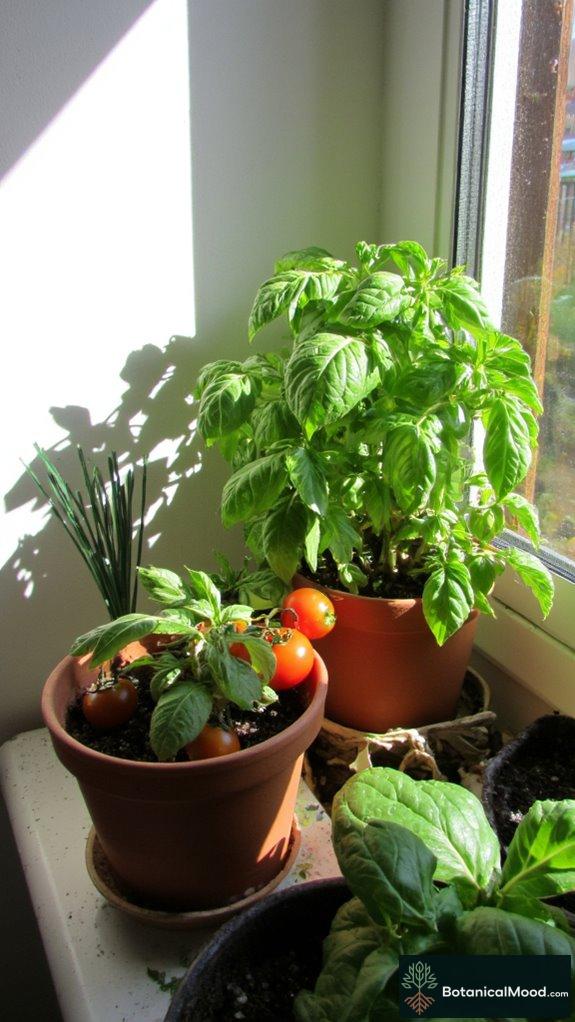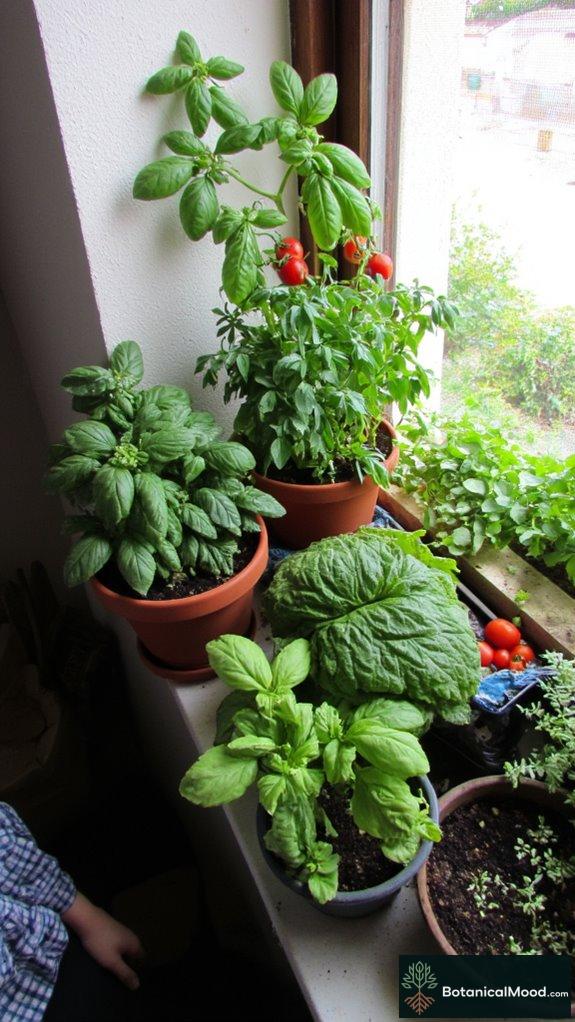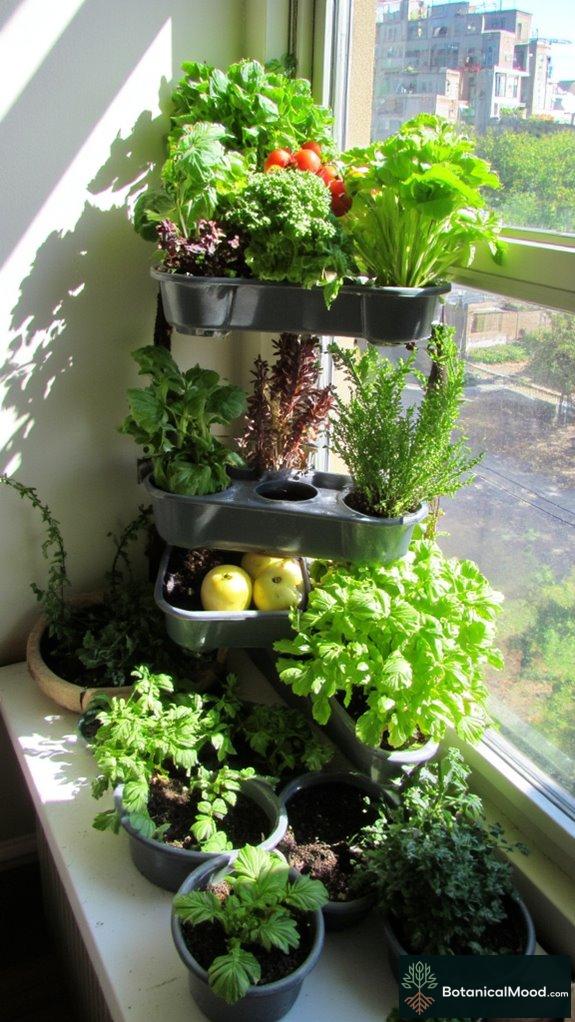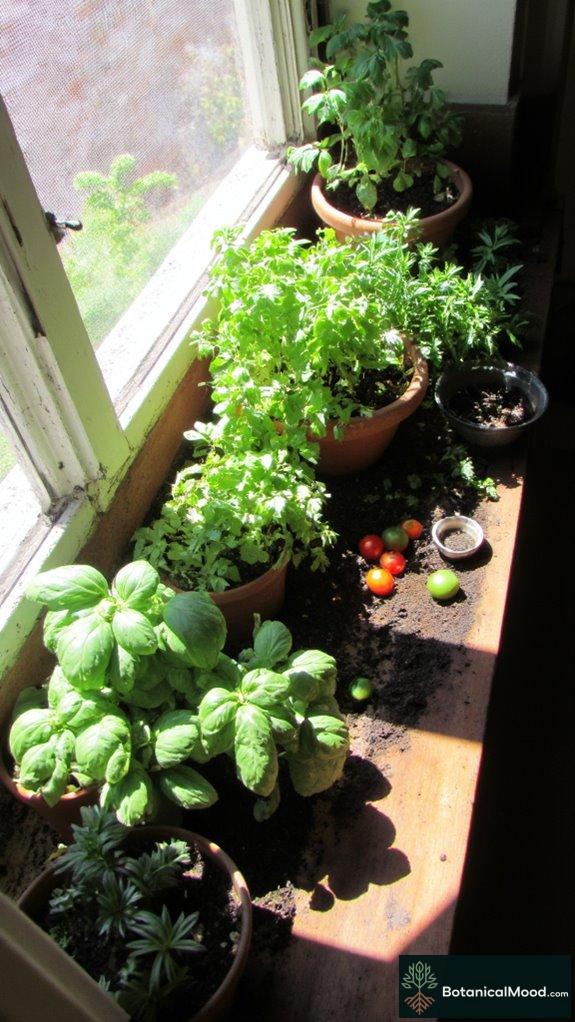Have you ever thought about having your very own veggie collection right on your windowsill?
Let me tell you, it’s a game changer!
I’ve got sleek, modern planters packed with rich soil and my favorite greens like spinach and kale. Yes, I’m practically a horticultural genius now.
With vertical trellises, I can make those climbing plants feel fancy, and don’t get me started on my upcycled produce trays—they’re basically my sustainability trophies.
You can layer pots for max yield while making sure each plant gets its light fix. You know, just casually growing my own salad while grocery shopping sounds like a serious win, right?
But hey, who doesn’t love trying out new urban gardening hacks?
Creative Window Gardens: My Vertical Experiment
Last spring, I decided to push the boundaries of my tiny kitchen. I fashioned a vertical garden using a mix of trellises and old wooden pallets.
I wanted to see just how much I could squeeze into that sun-drenched space. It was a wild adventure watching my little plants climb their way up—climbing beans and sweet peas running a race up the wall.
Every morning, I’d pluck a few fresh herbs for my omelette, and let me tell you: nothing beats that homegrown flavor.
It changed how I viewed small spaces entirely. Who knew a little creativity could bring such joy? From herbs to leafy greens, each plant became a little piece of me, sprouting right where I cook!
Quick Takeaways
- Utilize compact containers with well-draining soil to grow nutrient-rich greens like spinach and kale in limited spaces.
- Implement vertical gardening techniques with climbing structures to optimize space and enhance visual appeal on your windowsill.
- Pair companion plants, such as tomatoes and basil, to boost yields and deter pests effectively in small gardens.
- Incorporate decorative terracotta pots for aesthetics while ensuring proper drainage to promote healthy plant growth.
- Stagger plant maturity through succession planting to ensure a continuous harvest from your windowsill garden.
Compact Containers for Leafy Greens

When it comes to growing leafy greens, using compact containers can truly transform limited spaces, and I’ve found them to be both practical and aesthetically pleasing. Choosing the right soil selection is essential; I often opt for a well-draining mix enriched with organic matter to guarantee the best nutrient retention. Proper plant spacing, ideally 2-4 inches apart for species like Spinacia oleracea (spinach) or Brassica oleracea (kale), allows each plant to thrive without overcrowding. A variety of sleek, modern planter designs can enhance your windowsill while providing an inviting touch, perfectly suited for your vibrant indoor garden. Additionally, incorporating minimalist garden path configurations can help create a visually balanced environment that complements your greens.
Vertical Gardens: Utilizing Climbing Plants

Creating a vertical garden not only maximizes your available space but also adds a striking visual element to your windowsill.
I love employing climbing structures such as trellises or wall-mounted planters to facilitate space optimization, making my gardening endeavors both efficient and aesthetically pleasing.
For instance, I often use sweet peas (Lathyrus odoratus) or climbing cucumbers (Cucumis sativus) that thrive vertically.
Choosing plants with vibrant flowers or lush foliage enhances the visual appeal, while ensuring a delightful harvest.
This approach not only showcases beauty but also allows me to maintain control over my gardening environment, reflecting my passion for nature and design seamlessly. Additionally, incorporating vertical gardening techniques can significantly enhance the productivity of compact spaces, enabling a flourishing indoor garden.
Companion Planting for Enhanced Growth

Companion planting takes advantage of the natural relationships between plants, fostering an ecosystem where various species thrive together in harmony, enriching each other’s growth.
By strategically pairing plants, like tomatoes (Solanum lycopersicum) with basil (Ocimum basilicum), I’ve discovered significant companion benefits. These combinations not only deter pests but also boost flavor and overall yields.
When applying these planting tips, consider height, root depth, and nutrient requirements.
Marigolds (Tagetes spp.) can naturally repel nematodes, ensuring that my lettuce (Lactuca sativa) flourishes without competition.
With these techniques, I create a vibrant, productive windowsill garden, so the beauty and functionality of gardening harmonize beautifully.
Upcycled Produce Trays for Sustainable Gardening

Although many might overlook them, upcycled produce trays can serve as an ingenious solution for sustainable gardening on your windowsill.
These trays, often made from sturdy plastic or recycled wood, allow me to efficiently use upcycled materials while nurturing herbs and vegetables like Basil (Ocimum basilicum) or Cherry Tomatoes (Solanum lycopersicum).
By incorporating efficient drainage holes, I create the perfect environment for healthy root systems.
Using sustainable methods, I maximize space without sacrificing design, creating a visually appealing display.
Plus, I love the satisfaction of transforming waste into functional beauty, showcasing my commitment to both gardening and environmental responsibility.
Layered Pots for Maximum Yield

Layered pots present an innovative approach to maximizing yield in windowsill vegetable gardens, allowing me to cultivate a diverse range of plants in limited space.
By employing layered gardening techniques, I can create container synergies between complementary vegetables like basil (Ocimum basilicum) and tomatoes (Solanum lycopersicum). I arrange pots thoughtfully, ensuring plants that thrive in different light and water conditions work together harmoniously.
This design not only increases my productivity but also enhances the aesthetic appeal of my space. Each layer becomes an opportunity to experiment with vibrant colors and textures, making my windowsill a living work of art that embodies nature’s beauty.
Herb and Vegetable Mixes for Limited Space

Creating an enchanting windowsill garden requires an understanding of how to combine herbs and vegetables that not only thrive in harmony but also enhance the aesthetic appeal of limited spaces.
For a successful herb and vegetable mix, I love pairing vibrant basil (Ocimum basilicum) with compact cherry tomatoes (Solanum lycopersicum). These herb varieties provide a delightful contrast in color and texture while maximizing your crop yield.
Furthermore, chives (Allium schoenoprasum) work remarkably well alongside spinach (Spinacia oleracea); their subtle flavors elevate each dish.
Seasonal Planting Strategies for Year-Round Harvests

Selecting the right herbs and vegetables for your windowsill garden isn’t just about aesthetics; it’s also about how to keep those plants producing throughout the year. By aligning your seasonal crops with a well-planned planting calendar, you’ll gain a sense of control in your gardening endeavors.
| Season | Recommended Crops |
|---|---|
| Spring | Basil (Ocimum basilicum), Spinach (Spinacia oleracea) |
| Summer | Cherry Tomatoes (Solanum lycopersicum var. cerasiforme), Peppers (Capsicum spp.) |
| Fall | Kale (Brassica oleracea var. sabellica), Swiss Chard (Beta vulgaris) |
| Winter | Microgreens (various), Potted Herbs (various) |
| All Year | Green Onions (Allium fistulosum) |
Utilizing these strategic choices, I’ve found immense satisfaction in cultivating a vibrant year-round garden.
Innovative Vertical Plant Towers

Innovative vertical plant towers represent a transformative approach to urban gardening, making it possible to cultivate a remarkable number of plants in minimal space.
These vertical plant innovations maximize stacking efficiency, enabling me to grow ten times more crops per square meter, especially in urban areas where space is limited.
Clever Stacking Systems for Veggies

When you embrace clever stacking systems for veggies, you’re tapping into a world of garden possibilities that transform even the most confined spaces into vibrant green havens.
Here are four effective ways to utilize these systems:
Discover innovative methods to optimize your garden space with clever stacking systems for vegetables.
- Stackable planters: Create compact units for varied veggies, providing a maximum yield in minimal space.
- Vertical modules: Optimize height by layering, accommodating over 30 plants in just a 2 ft x 2 ft area.
- Integrated composting systems: Enhance nutrient delivery effectively with a vertical tower that nurtures your plants.
- Multi-tier shelving: Maximize sunlight exposure and manage watering precisely across different levels.
Explore these designs that harmonize beauty with function.
Meet the Urban Gardener

Samantha Johnson, a passionate advocate for sustainable living from Portland, Oregon, started her windowsill vegetable garden after searching for fresh herbs and vegetables during the pandemic, igniting her love for gardening.
To design her ideal urban garden, Johnson researched container gardening and consulted books from horticulturists like Martha Stewart and the Old Farmer’s Almanac. She sketched her layout, focused on maximizing sunlight, and selected a mix of herbs and vegetables suitable for indoor growth.
Using products like the AeroGarden for hydroponics, and high-quality soil from Miracle-Gro, Johnson cultivated her garden.
She equipped herself with tools from Fiskars and accessorized with decorative terracotta pots to enhance her urban oasis.
Urban Garden Layout Techniques

Creating an efficient layout for your urban garden can transform even the smallest of spaces into a productive haven where greenery thrives amidst the concrete jungle.
To achieve superior garden space, I apply layout improvement techniques, utilizing square foot gardening to maximize yield and vertical structures for upward growth.
I stagger crop maturity through succession planting and carefully select compatible species, ensuring each plant’s size fits perfectly within the space.
Moreover, I create pathways for accessibility and layer plant heights for enhanced light exposure.
Summary
I’m starting a windowsill vegetable garden to enjoy fresh produce right at home. Using techniques like companion planting and layered pots helps optimize my small space. It’s amazing how much I can grow in such a compact area!
I’d love to hear about your experiences with windowsill gardening. What challenges did you face, and what successes have you achieved?
Feel free to share pictures of your own garden setup and tell us how you designed it!
References
- https://www.gardenersworld.com/plants/windowsill-veg-container-ideas/
- https://theethicalist.com/7-easy-ways-create-garden-on-windowsill/
- https://www.ruralsprout.com/windowsill-vegetable-garden/
- https://joegardener.com/podcast/small-space-vegetable-gardening-mark-ridsdill-smith/
- https://www.youtube.com/watch?v=mzBNaaSiA6A
- https://www.youtube.com/watch?v=dBfkBaEcdSI
- https://altogarden.com/blog/benefits-of-vertical-hydroponics/
- https://farmonaut.com/blogs/vertical-hydroponic-system-7-shocking-urban-benefits
- https://sculptgarden.com/5-top-benefits-of-using-a-tower-garden-over-traditional-gardening/
- https://agrotonomy.com/top-7-benefits-of-a-tower-farm/
- https://www.plantscapelive.com/blog/what-you-need-to-know-about-grow-towers/
- https://curiodyssey.org/blog/the-science-of-garden-towers/
- https://verdeprofilo.com/en/benefits-vertical-gardens-for-offices/
- https://www.gardentowerproject.com/products/garden-tower-2-composting-container-garden
- https://foodgardening.mequoda.com/daily/garden-design/vertical-vegetable-garden-design-ideas-for-small-spaces/
- https://www.youtube.com/watch?v=JUiSugmZnmY
- https://thehomesteadingrd.com/vertical-garden-kits/
- https://mrstacky.com
- https://shop.epicgardening.com/collections/vertical-gardening
- https://greenstalkgarden.com/products/5-tier-greenstalk-original-vertical-planter-stunning-stone-basic-texture
- https://greenstalkgarden.com
- https://freckledcalifornian.com/2021/03/05/tips-for-creating-a-garden-crop-plan-layout/
- https://pmc.ncbi.nlm.nih.gov/articles/PMC9448568/
- https://phsonline.org/for-gardeners/gardeners-blog/how-to-create-a-resilient-urban-garden
- https://pmc.ncbi.nlm.nih.gov/articles/PMC9578910/
- https://dug.org/gardening-resources/garden-planning/
- https://kinder.rice.edu/urbanedge/urban-gardening-has-taken-root-and-its-time-cities-encourage-new-growth

Leave a Reply